Brewster Buffalo Mk. 1 – 1/32nd Special Hobby
Here is my Special Hobby Brewster Buffalo Mk. 1 in 1/32nd scale. I will say a few things about this high quality short-run kit later, but first I would like to give some historical background to the subject.
The History in Brief
The markings represent the aircraft of Sgt Pilot M N “Mac” Read, 453 Squadron RAAF, Malaya, December, 1941. Most written accounts accompanying profiles of this aircraft refer to the death of the pilot after he rammed a Ki. 43 Oscar on December 22nd , having “run out of ammunition”. More details are worth sharing about Mac Read's brief but intense combat career prior to his death at only 24 years of age. Read's squadron, 453 RAAF was amongst the Buffalo-equipped units virtually wiped out by overwhelming Japanese numbers over the month of December, 1941. However, it also experienced some notable successes in its short, doomed defense of Malaya.
Read learned to be a skilled dogfighter in the Buffalo, credited with the destruction of 2 Ki.48 Sonyas and one shared in a December 13, 1941 engagement, according to airpower historian Brian Cull. The aircraft this model portrays- W8209 - was the plane he flew on that date. The December 13th battle was a ferocious turning fight between just three Buffaloes and 21 Ki-48s and Ki. 51s. Read and his flying partner Sgt Bill Collyer had only just arrived at Ipoh airfield in Malaya, being in the process of ferrying their newly assembled Brewsters from Sembawang, Singapore. Low on fuel, they suddenly took off to engage the Japanese bomber formation which they witnessed bombing shipping in nearby Penang Island Harbor. Climbing to nearby cloud cover they then dived undetected on the enemy to engage in a diving, turning fight with the Ki-48 Sonyas. When they finally landed again at Ipoh, they were cheered on by local witnesses hitherto overwhelmed by relentless Japanese air attacks. For his personal role in this action, Read was recommended for a DFM, noting that he had not only shot down 2.5 aircraft but had subsequently landed to re-arm and refuel his damaged plane to ground strafe enemy transports. By the time the recommendation was submitted, however, Read had already been killed and the DFM could not be awarded posthumously.
Read's final, fatal engagement was also the last for the 453rd in Malaya (it was eventually reduced to just three aircraft and disbanded). It was also the first in which they met Ki. 43 Oscars. Cull's book has detailed accounts from Australian and Japanese perspectives, as well as from Indian troops who found the aircraft wreckage. On the morning of December 22nd, 1941, eleven Buffaloes engaged 18 Ki.43 Oscars of 64th Sentai over Kuala Lumpur. Read was almost certainly in a fight with a Lt Takeo Takayama, who had already shot down three Buffaloes in the air battle, according to the Japanese. The Sentai commander Tateo Kato believed that Takayama's aircraft had structural failure of its wings while chasing Read. Indian troops, however, found bullet holes in the tail section of the wreck, suggesting Read had shot him down. Interestingly, almost all of the surviving Oscars had damage to their wing roots from maneuvering after the fight. This revealed both the weaknesses of the Japanese plane – much to the frustration of Kato - and the fight put up by the Australians. Eye witness accounts on both sides suggest a final, catastrophic collision, perhaps accidental, between Takayama's Oscar and Read's Buffalo during a low level climax to their dogfight. In any case, both planes were destroyed and both pilots lost their lives. Read was given official, posthumous credit for the kill as an aircraft destroyed by ramming.
The Buffalo was at first well-liked then judged inferior to its main Japanese opponents by the Australians and New Zealanders and a smaller number of British pilots that flew it. Nonetheless, it is calculated by Australian sources to have had an at least 2:1 kill ratio to its Japanese adversaries in the Malayan and Singapore campaigns. Much more could be said of its mechanical and design issues, but suffice it to say it was probably a much better aircraft in RAF service than generally acknowledged by the British. Australian and New Zealand pilots who flew it, including Mac Read of New South Wales, Australia got the very best out of the aircraft in grueling conditions. For that, they and the Buffalo deserve to be remembered.
The model
This was a fun kit to build. It is short run with the usual challenges. Here are some of the things I did (which you can see in the Work in Progress- Aircraft Group Build, if you are interested).
I detailed the cockpit sidewalls, mostly from scratch with wiring, new throttles, console switches and very specific accurate bits from a labeled pilots manual I found online, including the RAF-style gunsight. The kit etch IP is excellent so I used that.
The RAF seat and seat armor were refined and an accurate tubular support system scratch built.
I scratch built the engine ignition harness from styrene rod, stretched sprue and solder.
All cockpit masking was done without commercial pre-cut masks.
Wing lights and fuselage formation light were made from stretched sprue, painted for the wing lights in clear green and clear red.
Antenna wire is E Z Line with stretched sprue insulator.
Kit decals are excellent and used throughout.
Upper camouflage painted with Gunze Dark Earth and RAF Dark Green, thinned with Tamiya Thinner and Acrylic Retarder (which works beautifully for a very smooth finnish)
Lower Camo/ID colours with MM Acryl Duck Egg Blue (very good) and MM Acryl Semi Gloss Black (not recommended! - too fragile and extensivley repaired with Tamiya Flat Black
Clear Coated with Tamiya Clear + Retarder
Oil wash
MM Acryl Flat for sealer and semi-matt finish
To summarize, I really like this model and this aircraft in RAF colors. My next Buffalo project will be the Special Hobby Brewster 239 in Finnish service in the same scale. For now, I hope you will be interested in this one.
On to the pictures:
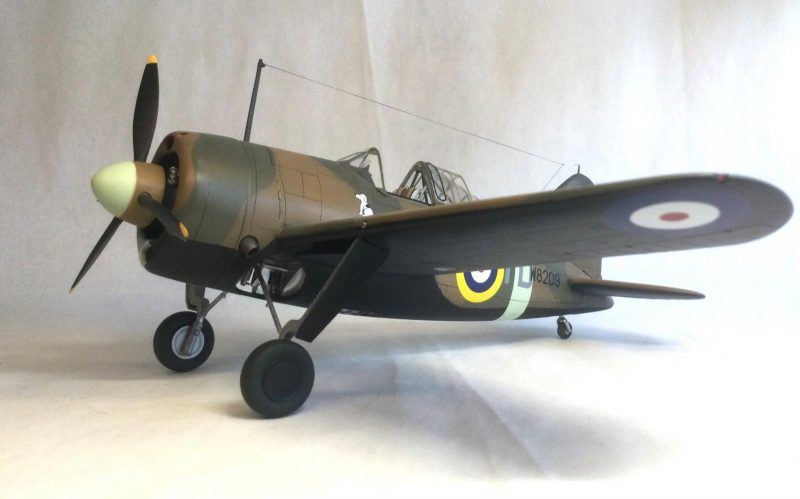
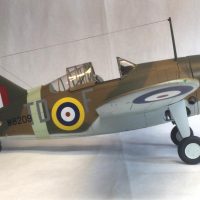
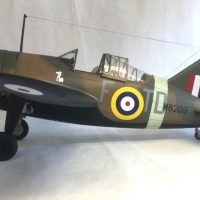
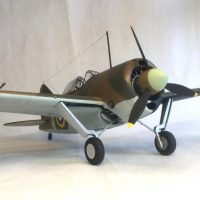
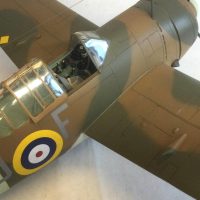

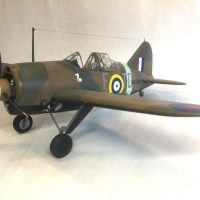
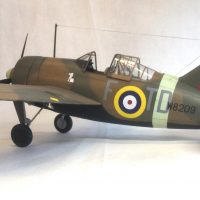
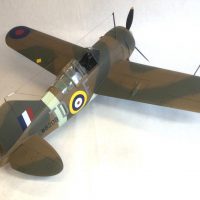
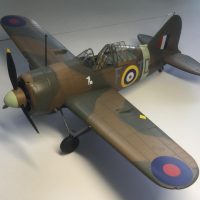

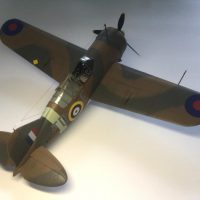
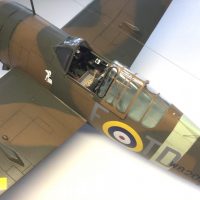
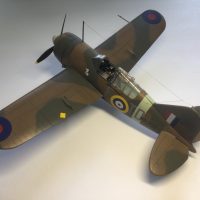
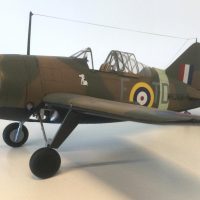
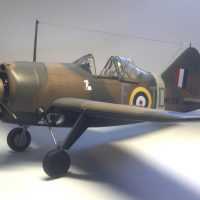
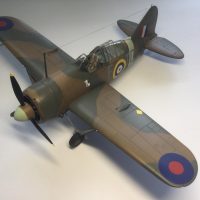
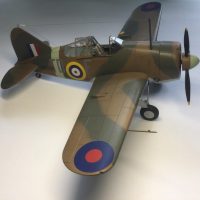
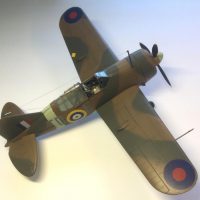
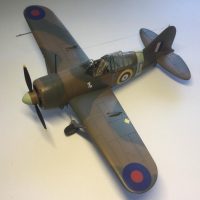
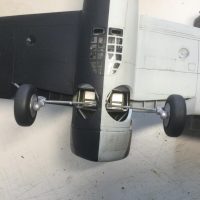
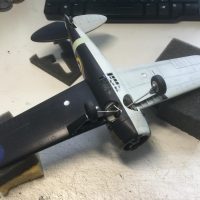
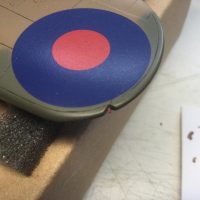
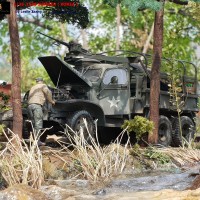



Let me be the first to congratulate you, Colin. This is a tremendous build, well documented in the WIP, and the pictures are first class. I also enjoyed reading the history of the Buffalo in this field of combat. I definitely liked this.
Thank you, George! I am very happy that the lengthy GB thread was worth following. As to the finished model, it was a project well worth finishing for me, even if I left it in suspension for awhile.
Me too,outstanding!
Thanks, Marcus. It was also great to have your words of encouragement as the build came together.
Excellent, Colin! I’ve been waiting for this one to be finished.
Thank you, John. It is good to have it posted, finally. Quite a process to keep the finish intact during the photography process. I used pics of the WIP for the underside because I didn't dare to flip it over with so much detail to worry about topside.
This is a truly wonderful model, my friend @coling!
Not only you tackled the enjoyable but very difficult short run Special Hobby kit with excellence, but also you improved it in numerous areas in a most amazing and attended to detail manner. This could clearly be realized from the start, once you started improving at the seat and its surrounding area: it was evident that it would be another extremely detailed, fantastic build, typical Colin Gomez style.
Your build thread was equally amazing and detailed, a joy to follow; thanks for sharing all your techniques with us.
The headlines article was super! Did not know about "Mac" Read, what a great story!
Congratulations on all, looking forward to your Finnish one!
Thank you, Spiros. I am grateful for your detailed comments and careful observations of the build, both as a WIP and now that it is finally done. This is the first time I've done an historical background segment. The commentary on Read's fate being usually quite short, I found it worth reading the relevant sections of Cull's superb book carefully. The story I reconstructed in my own words from the various voices in the book. Feeling we are memorializing such moving stories with our models helps me, at least, to do the build the best that I can. It's great if the techniques that come up or are invented to get a build done can benefit friends and fellow modelers.
An outstanding result Colin, @coling
Following your thread, it is clear that you really enjoyed building this Buffalo.
Thanks for sharing the work in progress, it was a pleasure to follow the thread.
Thanks, John. It was great to have your kind encouragement in the WIP stages. If my enthusiasm for the build came across, even better. I am looking forward to seeing your Walrus competed soon - that is one very challenging project.
It's amazing what the Buffalo was able to accomplish, given that the airplanes the British got were powered by clapped-out/overhauled Wright Cyclones taken off DC-3s. The engines didn't have the power of the F2A=1 engine, and the airframes were close to 1,400 pounds heavier. The engines frequently overheated in operations in Malaya.
There's a good possibility Read may have put some shots into Takayama's Oscar, but structural failure of the wings due to the fact the JAAF had complained the Ki.43-I wasn't maneuverable enough compared to the Ki.27, so the design was lightened past structural integrity in the production aircraft, something not completely solved till the Ki.43-II; the wingroot of the Ki.43-I was particularly weak, would have been a contributing factor like Kato thought it did. In a high-g turning battle like this, structural failure from maneuvering and perhaps from gunfire damage would have done it.
As to the "dogginess" of the Buffalo, General Marion Carl told me back in 1992 that if the Marines had had F2A-3s rather than F4F-4s at Guadalcanal, and had used the same tactics they did with the Wildcats, "the result would have been the same." By then, they had learned to get to 20,000 feet and make one diving pass, not sticking around to fight if possible. But in Malaya and at Midway, taking inexperienced pilots in an under-powered airplane and putting them in combat with highly-experienced opponents in a better-performing airplane will always have a bad result. According the General Carl, the only thing the Wildcat had better was a stronger landing gear. The F4F-4 had no more power than the F4F-3, and had two more guns and the wingfold mechanism, adding about 1,100 pounds to it.
I followed your build log on this @coling, and you have achieved an excellent result. Deiinitely "liked."
Thanks, Tom. I appreciate the artful summary of the Buffalo's mechanical issues and actual potential, when used well. I couldn't have summed it up so well myself. You are privileged to have spoken with so many honored veterans in your research. My only sense of their perspective has come for reading and TV documentaries and it is great that you have gotten a more personal conversational point of view.
I am glad you like the model. Thanks again for taking the time to follow the WIP and comment along the way.
Beautifully done Mr. Gomez. Great build all around.
Thanks, Bill. As I mentioned in the Group Build, I benefited greatly from your superb build of the same model. I am not sure how you figured out elements like the landing gear strut arrangement but it was a big help to see how you did it. You put more detail in your wheel bays than I was ready to risk, given the assembly and masking problems. My hat is off to you, sir and I am much obliged for the inspiration.
Colin, @coling
This is an exemplary build. I have been following your work in progress, and I will use it as a reference when I eventually start cranking out the Buffalo kits I have in my stash. The pictures you posted here in the headlines section also look exceptional.
I thoroughly enjoyed the written portion of this headline article as well.
I would say that you knocked the ball out of the park and hit a home run !
Well done my friend... VERY well done.
I definitely pressed the "liked" button. The only drawback, is that now we will no longer get regular updates in your magnificent work in progress journal... I really enjoyed that too. It was very informative. Thank you.
Thank you, Louis. It is great to have your words of encouragement. The pictures were a challenge but I am glad they convey the color and details accurately.
A beautiful build!
Thanks, Robert.
Truly great build and attention to detail.
Thanks, Haslam. Very kind of you to take the time comment. The detailing was a challenge but fun to do, in the end.
That's one exceptional Buffalo Colin, great paint job and nice attention to detail.
A lovely Buffalo - I also followed the WIP thread with great interest. Well done!
I read your story very carefully! Very interesting! Buffalo looking great!
Thank you, Lis. Glad you like the story and the model.